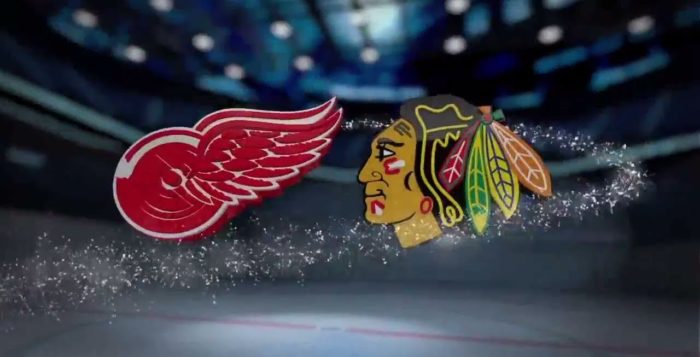This Day in Hockey History – December 17, 1957 – Four for Four
When the trade was made on December 17, 1957, it was the largest trade in NHL history. As the Detroit Free Press put it, four Detroit Red Wings were sent “on the assembly line that leads into the Blackhawks arena” and four Chicago Blackhawks were returned “on the treadmill that terminates at Olympia.” The two teams had already been trading players since the season before, so this seemed another in a string of them.
The trade took less than 24 hours to come about. Detroit’s Jack Adams and Chicago’s Tommy Ivan apparently (according to the Free Press) had a “session of hand-holding and mutual admiration [from which] came another in the endless series of trades.” Adams explained, “The negotiations started Monday afternoon when Tommy and I talked for an hour on the telephone. Then I called Bruce Norrice (Wings’ president) and he gave me the go-ahead. I phoned Ivan again Tuesday morning and we settled it.”
Detroit’s press was less than impressed with the quality of the players being traded. Tallied up from all eight of them, they had only scored 21 goals in 29 games. None of those being sent from Detroit to Chicago were playing on a regular line.
One reason for this was that Earl “Dutch” Reibel’s “Production Line” linemate, Ted Lindsay, had already been traded to Chicago along with goalie Glenn Hall (as a result of trying to form a players’ union). Now the 27-year-old center was the key to the trade that the Blackhawks most wanted. Adams was willing to set him loose because he was made expendable with the younger and faster Forbes Kennedy came through for the Red Wings as center.
In addition to Reibel, Detroit was sending away right wing Bill Dineen and left wings Billy Dea and Lorne Ferguson. Adams felt that neither Dineen nor Dea was “getting any place with the Wings. The trade may be a break.” As for Ferguson, Adams said, “He tightened up right after we got him from Boston and never played up to expectations.”
On the flip side, the key player leaving Chicago for Detroit was left winger Nick Mickoski. He was a 10-season veteran at the age of 30 and considered “the best defensive forward in the NHL.” Adams saw Mickoski as “a digger. He’ll give us a forward who is a good back-checker.”
Along with Mickoski, Chicago sent over right wing Bob Bailey, left wing Jack McIntyre, and center Hec Lalande. “We had [Bailey] for the play-offs last season and then lost him in the draft,” explained Adams. “He’s a tough hitter.” As for McIntyre, Adams thought, “Maybe the change will let him get going.” Finally, young Lalande had played little so far that season due to a broken toe, but Adams felt he “might help in spots.”
The new Red Wings would join the team for a home game against Toronto on December 19. Meanwhile, the new Blackhawks would report in time for practice with the team on December 18 and 19. However, the teams would soon be meeting each other on the ice in the back-to-back “commuters’ special.”
Chicago hosted a matinee on Saturday, December 21 for 5,678 fans. The rematch took place the next day, Sunday, December 22, featuring a crowd of 10,552 at Olympia Stadium. Judging solely by these first two showings after the player swap, the Red Wings had the better end of the bargain. They won 5-3 in the first game and 2-0 in the second. Previously that season, the Blackhawks had shut them out twice.
Of the five goals tallied by Red Wings in Saturday’s game, four of them were scored or assisted by ex-Hawks. Johnny Wilson and Forbes Kennedy, who had been traded for Lindsay and Hall, potted the first and last goals. Bailey assisted on the first, and Lalande assisted on the third. McIntyre joined his fellow trades by netting the second goal. Meanwhile, the Blackhawk’s scoring was only assisted by Reibel (of the traded players). The shutout that followed was Terry Sawchuk’s first since rejoining the Wings. It happened despite two full lines of Hawks made up of ex-Wings. Mickoski assisted on one of the two goals scored for Detroit, so every single one of the traded players sent from Chicago had a hand in the two victories.
Poor Chicago continued their 13-game losing streak. They had not had a win since December 4 or a home victory since November 10. At end of 1957-58 season, Chicago and Detroit were evenly matched against each other, each winning and losing seven games. Overall though, the Red Wings came out ahead with 70 points while the Blackhawks trailed with 55.
Additional Sources:
- Tommy Devine, “Wings and Hawks Exchange ‘Faces’ Again,” Detroit Free Press, 18 Dec. 1957, pp. 35-36.
- Charles Bartlett, “Hawks Get Reibel in 8 Player Deal,” Chicago Tribune, 18 Dec. 1957, pp. F1 and F4.
- Charles Bartlett, “Hawks’ Alumni Spark Wings’ 5 to 3 Triumph,” Chicago Tribune, 22 Dec. 1957, p. F3.
- “Hawks’ String Hits 13; Lose to Wings, 2-0,” Chicago Tribune, 23 Dec. 1957, p. F4.
- “Wings Run Down Hall, Hawks, 5 to 3,” Detroit Free Press, 22 Dec. 1957, p. E1.
- Marshall Dann, “Sawchuk Blanks Chicago,” Detroit Free Press, 23 Dec. 1957, pp. 33-34.
- https://thepinkpuck.com/2019/07/29/this-day-in-hockey-history-july-29-1925-growth-of-red-wings-left-wing/














